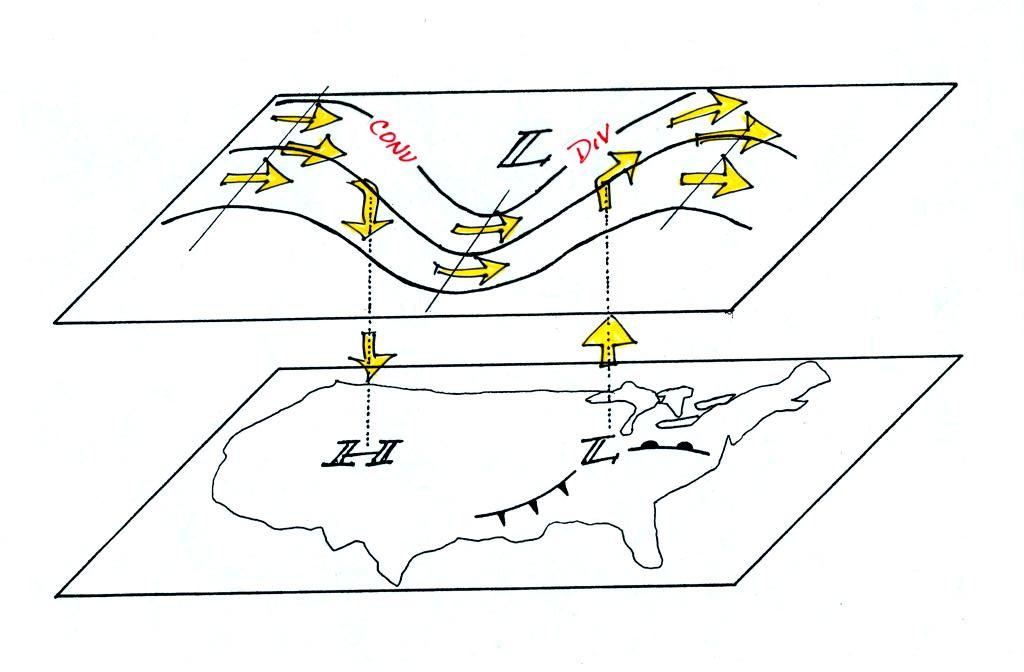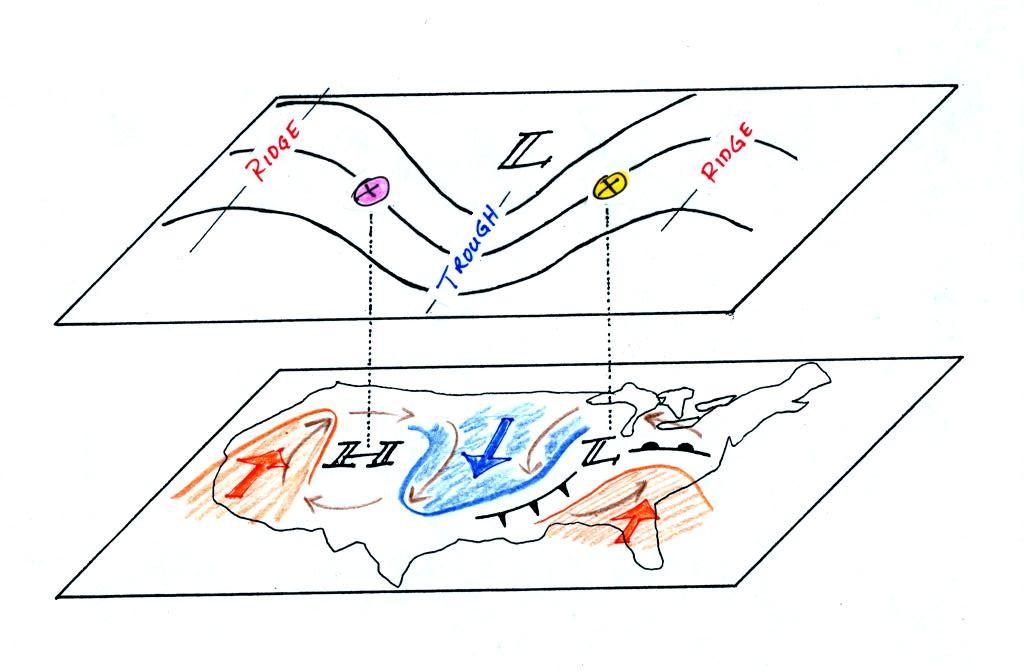

On
the surface map above you see centers of HIGH and LOW pressure.
The
surface low
pressure center, together with the cold and warm fronts, is a middle
latitude
storm.
Note how the counterclockwise winds spinning around the LOW move warm
air
northward (behind the warm front on the eastern side of the LOW) and
cold air
southward (behind the cold front on the western side of the LOW).
Clockwise winds spinning around the HIGH also move warm and cold
air. The
surface winds are shown with thin brown arrows on the surface map.
Note the ridge and trough features on the upper level chart. We
learned
that warm air is found below an upper level ridge. Now you can
begin to
see where this warm air comes from. Warm air is found west of the
HIGH
and to the east of the LOW. This is where the two ridges on
the
upper level chart are also found. You expect to find cold air
below an
upper level trough. This cold air is being moved into the middle
of the
US by the northerly winds that are found between the HIGH and the
LOW.
Note the yellow X marked on the upper level chart directly above the
surface
LOW. This is a good location for a surface LOW to form, develop,
and
strengthen (strengthening means the pressure in the surface low will
get even
lower than it is now. This is also called "deepening"). The
reason for this is that the yellow X
is a
location where there is often upper level divergence. Similary
the pink X
is where you often find upper level convergence. This could cause
the
pressure in the center of the surface high pressure to get even higher.
This
section examines in more detail how upper level winds can
affect the
development or intensification of a surface storm.
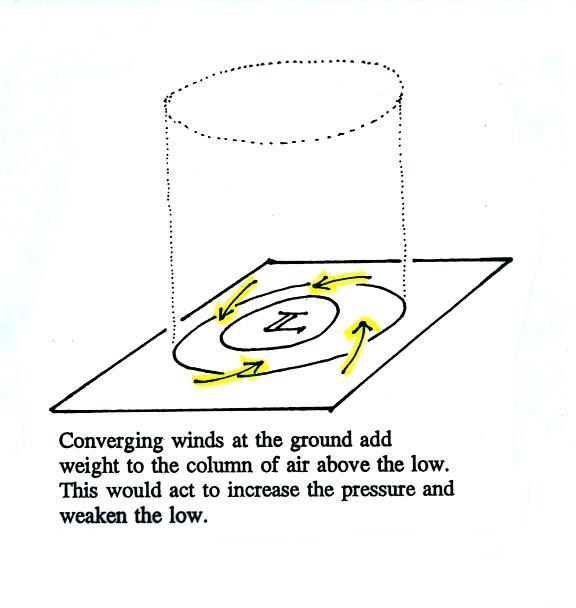
This
figure (see p. 42 in the photocopied Classnotes) shows a cylinder of
air
positioned above a surface low pressure center. The pressure at
the
bottom of the cylinder is determined by the weight of the air
overhead.
The surface winds are spinning counterclockwise and spiraling in toward
the center
of the surface low. These converging surface winds add air to the
cylinder. Adding air to the cylinder means the cylinder will
weigh more
and you would expect the surface pressure at the bottom of the cylinder
to
increase.
We'll just make up some numbers, this might make things clearer.
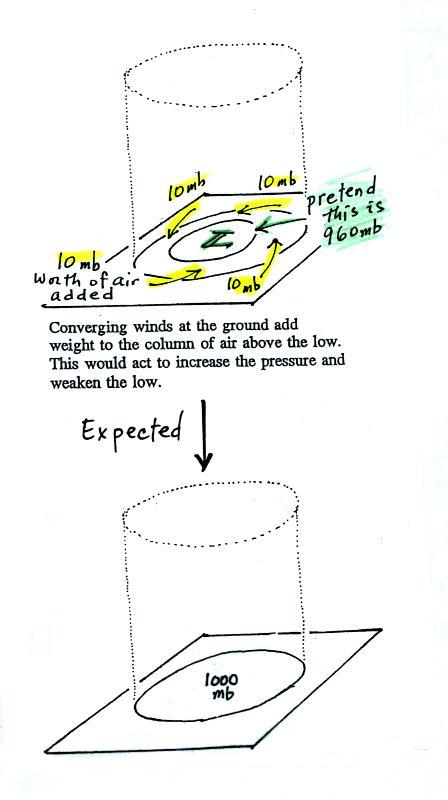
You'll
find this figure on p. 42a in the Class Notes. We will assume the
surface
low has 960 mb pressure. Imagine that each of the surface
wind
arrows brings in enough air to increase the pressure at the center of
the LOW
by 10 mb. You would expect the pressure at the center of the LOW
to
increase from 960 mb to 1000 mb.
This is just like a bank account. You have $960 in the bank and
you make
four $10 dollar deposits. You would expect your bank account
balance to
increase from $960 to $1000.
But what if the surface pressure decreased from 960 mb to 950 mb as
shown in
the following figure? Or in terms of the bank account, wouldn't
you be
surprised if, after making four $10 dollar deposits, the balance went
from
$960 to $950.
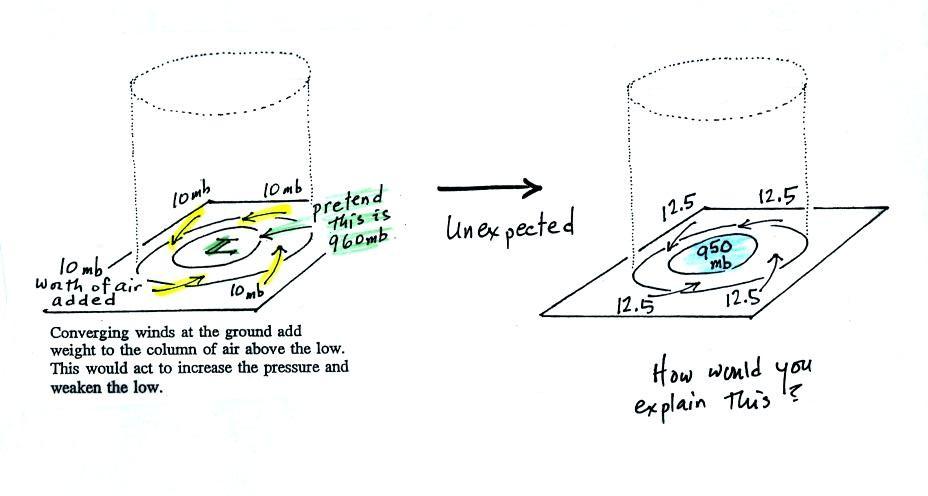
The
next figure shows us what could be happening (back to p. 42 in the
Class
Notes).
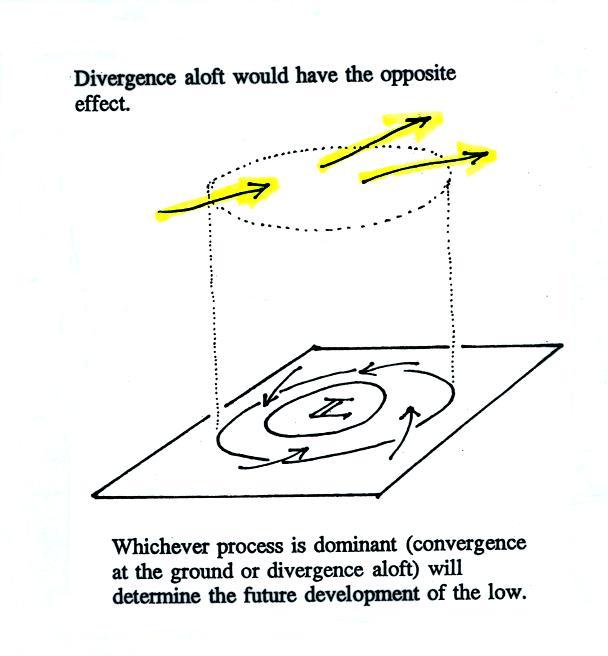
There
may be some upper level divergence (more arrows leaving the cylinder at
some
point above the ground than going in). Upper level divergence
removes
air from the cylinder and would decrease the weight of the cylinder
(and that
would lower the surface pressure)
We need to determine which of the two (converging winds at the surface
or
divergence at upper levels) is dominant. That will determine what
happens
to the surface pressure.
Again some actual numbers might help (see p. 42b in the Class Notes)

The
40 millibars worth of surface convergence is shown at Point 1. Up
at
Point 2 there are 50 mb of air entering the cylinder but 100 mb
leaving.
That is a net loss of 50 mb. At Point 3 we see the overall
result, a net
loss of 10 mb. The surface pressure should decrease from 960 mb
to 950
mb. That change is reflected in the next picture (found at the
bottom of
p. 42b in the Class Notes).

The
surface
pressure
is
950
mb.
This
means there is
more of a pressure difference between the low pressure in the center of
the
storm and the pressure surrounding the storm. The surface storm
has
intensified and the surface winds will blow faster and carry more air
into the
cylinder (the surface wind arrows each now carry 12.5 mb of air instead
of 10
mb). The converging surface winds add 50 mb of air to the
cylinder (Point
1), the upper level divergence removes 50 mb of air from the cylinder
(Point
2). Convergence and divergence are in balance (Point 3).
The storm
won't intensify any further.
Now that you have some idea of what upper level divergence looks like (more air leaving than is going in) you are in a position to understand another one of the relationships between the surface and upper level winds.
